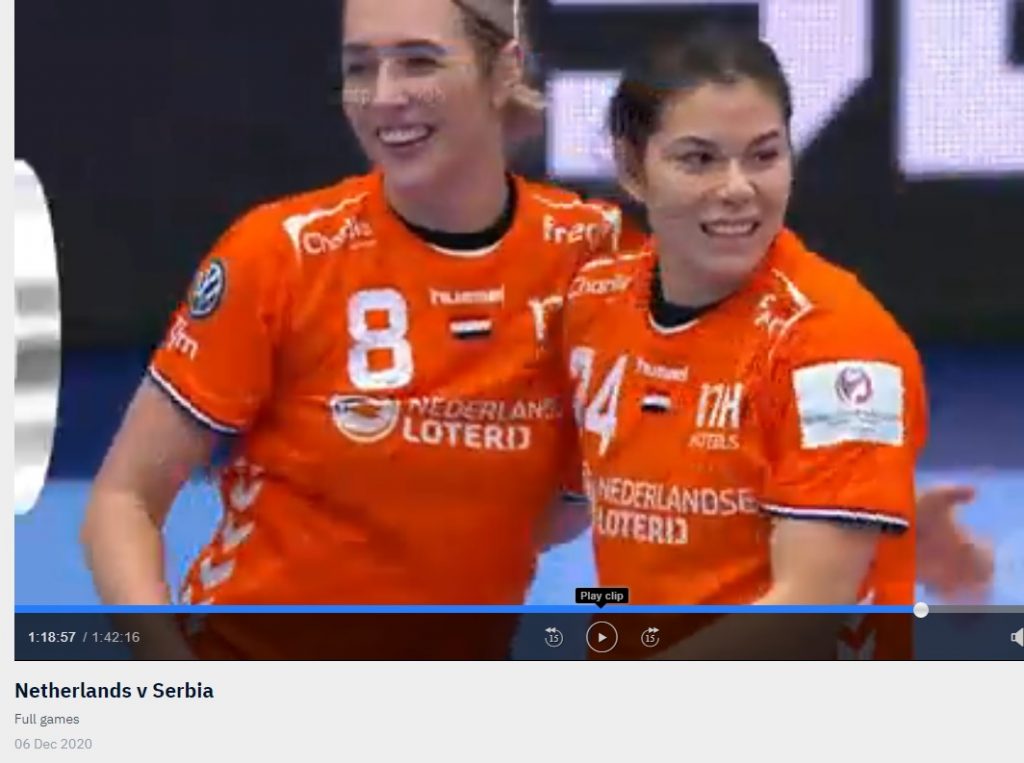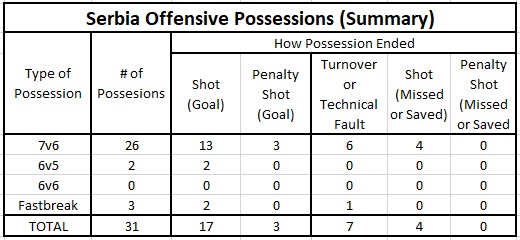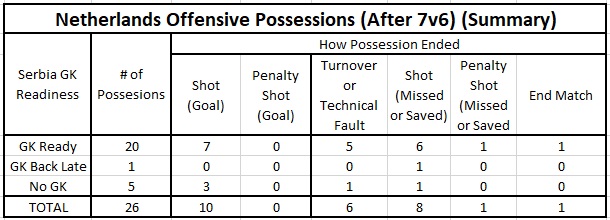
We’ve all seen it… We’ve all thrown objects at the TV… We’ve all cursed at the stupid coach when yet another ball is casually thrown into the empty net. The 7v6 strategy is a hopeless strategy and it never works… Except when it does.
Down 6 at the Half and Running out of Options
Lost in the midst of Croatia’s incredible run of surprising wins at the 2020 Women’s European Championship was arguably the most remarkable upset of the entire tournament: Serbia’s come from behind 29-25 defeat of the Netherlands in the preliminary round.
The match surely didn’t look like an upset for the first 43 minutes of the game. At halftime the defending World Champions, the Netherlands, had a commanding 15-9 lead and to make matters worse for Serbia they had lost their star player, Andrea Lekić, to injury. Without any obvious solutions, Serbian coach, Ljubomir Obradovic, decided to switch things up dramatically at halftime, choosing to employ the 7v6 offensive strategy. This tactic involves pulling your GK on offense and replacing them with an extra player on offense. This is called 7v6 since the offensive set has 7 offensive court players playing against 6 defensive court players.
7v6 Pros and Cons
The one obvious advantage to this strategy is that, in theory, one offensive player is always open and unguarded by the defense. The other less obvious advantage is that the extra circle runner generally forces defenses to hug the 6 meter line more closely, thus opening up more jump shot possibilities.
The obvious drawback to this strategy is the open net at the other end of the court. If you turn the ball over chances are the defense is going to get an easy goal. The same is true if the GK makes a clean save and retrieves the ball quickly, or worse, catches it. Perhaps nothing demonstrates this more ably than this video compilation that the (Un)informed Handball hour put together to highlight Croatia’s use of the strategy against Brazil at the 2019 Men’s World Championship. The six empty net goals were certainly a huge factor in Brazil’s 29-26 upset win.
The First 11 Minutes of the 2nd Half: Decent Results, but Simply Trading Goals
Serbia – Netherlands Match Video: Link (The 2nd half starts 1:03:27 on the ehfTV clock.)
For the first 11 minutes of the 2nd half the strategy works fairly well. Serbia has 9 possessions using the 7v6 strategy and they score on 5 of them. And, the Netherlands also fails to cash in on two empty net opportunities with GK Tess Wester whiffing on a long shot and Dannick Snelder getting blocked on a fast throw off shot after a made goal, by a just in time return by Serbian GK, Jovana Risovic. At the 38:42 minute mark the score is 20-14 with both teams have scored 5 goals a piece. The Netherlands then gets a 2 minute penalty and Serbia scores 2 goals when playing 6v5, cutting the lead to 20-16.
A Huge Setback: Back to Back Empty Net Goals
With the lead cut to four goals Serbia seemed to be showing some signs of life, but then at the 41:36 minute mark everything seemingly falls apart. On back to back possessions Serbia turns the ball over to the Netherlands for 2 open net goals. In less than a minute the score is 22-16 and the game is right back where it was at the start of the 2nd half, a 6 goal deficit.
There aren’t too many things more demoralizing to a team than a string of empty net goals in quick succession. It’s one thing to give up a goal after playing tough defense for 40 seconds. It’s another thing entirely to watch the other team effortlessly score against literally no defense whatsoever. On more than one occasion I’ve seen obviously demoralized players hanging their head, or worse, glaring with not very well concealed anger toward their coach and the stupid 7v6 strategy the coach is making them play.
We don’t see anything like that, however, from Serbia in the video feed. Instead, we see the Netherlands team with all smiles. The defending World Champions have weathered the storm. They’ve got a 6 goal lead and things are seemingly looking good for them in their opening match of the tournament.
Cue Tchaikovsky’s 1812 Overture: Time for a 7 Goal Barrage from Serbia
But, as we all know in handball, “seemingly” is often replaced with “reality.” And, the reality that happens in just 6 minutes is a combination of great defense at one end combined with a textbook, masterclass in how to execute the 7v6 tactic at the other end. 7 offensive possessions for 7 straight goals and a 22-16 deficit turns into a 23-22 lead. One of the goals is on a fast break, but the other 6 are all scored using the 7v6 offensive strategy. And, the shots come from all over the place. Wing shots, breakthroughs and jump shots now coming from a bit shorter range thanks to the strategy.
Why, if I had better video editing skills I would make a video like the (Un)informed Handball Hour did, but this time I would replace the Dating Game theme with the 1812 overture with each of the 7 goals being synchronized with the cymbal clashes.
Seriously, it’s a rapid and relentless beatdown worth reviewing. For the full effect, start by first watching the Netherlands score their two fast break goals (1:17:15 on the ehfTV clock)
Continued Execution, but at a Less Efficient Pace
The remaining 11 minutes offer more of the same, but the success rate drops from perfect to just pretty good. Serbia just scores on 5 of its 8 remaining 7v6 possessions. They also turn the ball over a couple of times with one of those turnovers leading to an empty goal for the Netherlands. Serbia’s defense also allows a couple of more goals for a final score of 29-25.
Keys to Success
Here are a couple of summaries of the 2nd half. First, a look at Serbia’s offensive possessions.

Key 1: High offensive efficiency: 16 of Serbia’s 26 7v6 possessions resulted in a goal, a success rate of 62%. That’s pretty good and certainly better than the 9 for 28 (32%) success rate in the first half. I’d have to do more research on Serbia’s average over several matches, but I think it’s safe to say that 2nd half performance was well above average.

Key 2: GK Readiness: Perhaps, just as important if not more important was Serbia’s GK readiness following 7v6 possession. Of the 26 7v6 possessions their GK was read in the net on 20 of those possessions. And, the Netherlands was only able to cash in with goals on just 3 of the 6 possessions when the GK was either late or not in the goal at all.
The Real Key (scoring instead of turnovers): However, it should be noted there is a huge correlation between 7v6 offensive success (scoring a goal) and GK readiness. And, of course, there is a huge correlation with turnovers and GKs not being ready on the other end.
An Outlier?
Well, clearly this match is documented proof that the 7v6 strategy can be very, very effective. But, is it simply an outlier amongst an overwhelming number of failures like the Brazil-Croatia match? I wish I knew the answer to that question, but I don’t. To varying degrees I’ve seen this strategy work before. In fact, back in 2016, I saw Belgium almost pull off a similar upset against France. At the time, I chalked this up to an unprepared French team that didn’t know how to counteract this new fangled strategy. Four years later, no such excuse can be valid anymore.
Anecdotally, I can assess that this strategy fails more often it works. But, I don’t have the hard data to say how often it works and how often it fails. And, even if I did it would be hard to read too much into it because there are so many other factors to consider. In particular, a big part of Serbia’s comeback was their defense in the 2nd half.
But, here’s one aspect to consider: If one changes just 2 Serbia 7v6 possessions from goals to turnovers it’s likely a 4 goal swing, meaning 29-25 becomes 27-27. One always wants more goals than turnovers, but with 7v6 the impact of that ratio is even more pronounced. Perhaps one could even come up with a benchmark ratio for success if they had enough data.
Finally, regardless of what the numbers might say regarding how unlikely 7v6 was to work for Serbia, the reality is that it worked. And, it surely was more likely to have worked than a conventional strategy would have.
Translation: Sorry 7v6 haters: This strategy isn’t going away anytime soon. Not without a change to the rules, anyway.



